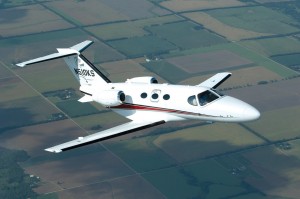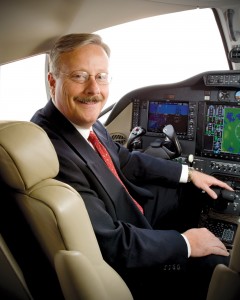By Karen Di Piazza
Cessna Aircraft Co. has plenty of experience when it comes to getting aircraft certified. It went for the gold, electing not to apply for provisional or baseline type certification on its Mustang. On Sept. 8, ahead of schedule, the 79-year-old Wichita, Kan.-based company became the world’s first aircraft manufacturer to obtain full TC on a twin-turbofan entry-level business jet—the Citation Mustang.

The Citation Mustang, a six-place, twin-turbofan entry-level jet, became the first VLJ to obtain full type certification by the Federal Aviation Administration on Sept. 8.
Although Jack Pelton, Cessna’s chairman, president and CEO, said in the past the aircraft wasn’t a very light jet, Cessna is now taking credit for certifying the world’s first VLJ.
“If it walks and quacks like a duck, it’s a duck,” joked Doug Oliver, spokesman for Cessna. “Absolutely, we take credit for being the company that has obtained full TC on the world’s first entry-level jet in the VLJ category; for its weight and class, there’s no denying that.”
He said Cessna is proud to lead the industry in this class of aircraft.
“It’s true that we stayed away from marketing the Mustang as a VLJ, primarily because of how they were initially thought of, which didn’t fit our line of established business jets,” he said. “It would be great to be able to move deliveries forward, too, to claim the title of first certified and first delivered. Who knows? Certification for some of the others may prove to be harder than they thought.”
Oliver said it’s appropriate that the Citation Mustang became the first jet certified in this class by the Federal Aviation Administration.
“The Mustang is the aircraft by which all others will be judged, in terms of performance, functionality, ease of operation and quality,” he said.
Pelton explained one of the reasons that Cessna shied away from marketing the Mustang as a VLJ is because of cabin space, plus its cutting-edge avionics.
“The Mustang has two external-access baggage areas, one in the tail and one in the nose,” he said. “Typically, with the VLJs, you have to bring the baggage in through the cabin and store it in the back of the airplane. And although the Mustang doesn’t have a walk-in lav, it does have a toilet—something other VLJs, such as the Eclipse, don’t have. The toilet has a curtain around it; from our focus group studies, we found it’s important to have that capability.”

Jack Pelton, chairman, president and CEO of Cessna, and Citation jet rated pilot, proudly sits in the left seat of the Citation Mustang, the world’s first certified jet in the very light jet category.
Priced at $2.6 million, the six-place Mustang, powered by two Pratt & Whitney Canada PW615F engines, is certified with a maximum ceiling of 41,000 feet, and only needs 3,120 feet of runway, based on maximum takeoff weight.
Pelton said they plan to deliver 50 Mustangs in early 2007, and 100 more by 2008.
Thus far, there are more than 250 orders for the Mustang, with the majority of orders coming from international customers; production is sold out well into 2009.
But with the Mustang now certified, and with more interest in it from the aviation industry, can Cessna ramp up production, delivering sooner that 2007? Not according to Oliver.
“When we originally started taking orders, we put contracts in place with a specific timetable that included a specific delivery slot,” he explained. “We’ve developed the program based on these delivery slots; making changes at this time isn’t practical.
The number of orders we get really has nothing to do with our delivery schedule.”
Pelton said the Mustang has met or exceeded every performance objective established since the company announced the program in 2002.
“We did what we said we’d do, and we beat the schedule doing it,” he said. “Cessna’s commitment to safety is evident in the Mustang, as it is in our entire fleet of aircraft. We met or exceeded all the requirements for the Mustang’s weight class; we went on to test the aircraft in many categories to commercial airliner standards. The Mustang was successfully tested to five airframe lifetimes—well past the required two lifetimes of testing—and was designed for an unlimited airframe lifetime.”
He said during the Mustang’s flight-testing, it achieved more than 2,200 certification test conditions, meeting or exceeding all the company’s program performance goals, including speed and range.
“There’s no question, the Mustang represents a first-class Cessna Citation business jet in every way,” he said.
FAA certification for the Mustang includes single-pilot operation, day/night operations, visual and instrument flight rules, and operations in reduced vertical separation minimum airspace.
“While not required for TC, we’ll be cleared for flight into known icing conditions in the next couple of weeks,” Pelton said.
On Sept. 20, the company confirmed the majority of that testing is complete in that area; all the Mustang needs is one 45-minute flight in a natural-ice condition.
Not only as Cessna’s leader, but also as a Citation rated pilot, Pelton is proud of the fact that the Mustang is the first aircraft to have an integrated flight deck that’s certified to take advantage of WAAS navigation features. Some of those features include WAAS LPV approaches that provide both lateral and vertical guidance. The Garmin G1000 avionics suite also includes a new feature, the SafeTaxiTM, which gives a graphical representation of the aircraft on the ground in the airport environment—a real safety enhancer.
Based on unit sales, Cessna is the world’s largest manufacturer of general aviation airplanes. In 2005, the company delivered 1,157 aircraft and reported revenues of about $3.5 billion. In fact, its global fleet of more than 4,500 Citations is the largest fleet of business jets in the world.
Currently, Cessna is working on obtaining European certification on its Mustang. Also, last month, Cessna and its parent company, Textron Inc., dedicated a new aerospace production facility, Textron Aerospace Mexico, in Chihuahua, Mexico. The 62,000-square-foot facility in Mexico will free up space at Cessna’s Wichita manufacturing plant. That way, Cessna can use more space for its new aircraft models; they plan to announce several in the coming years, maybe during the National Business Aviation Association’s annual convention this month in Orlando, Fla.
For more information on Cessna, visit [http://www.cessna.com].











